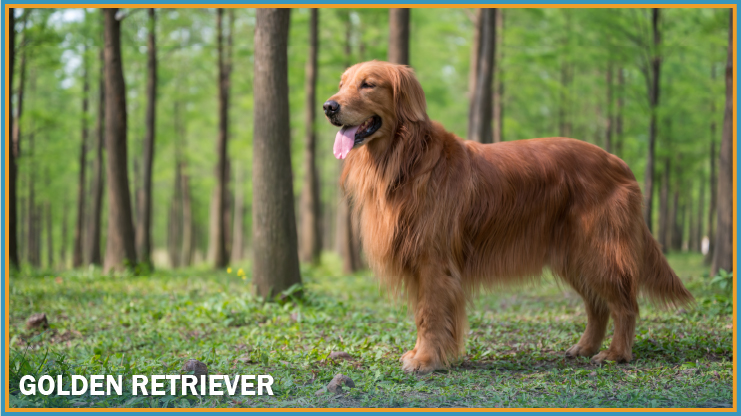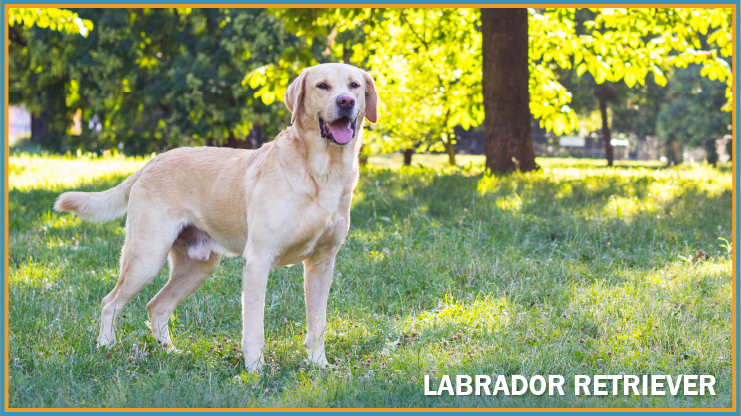
GOLDEN RETRIEVER VS. LABRADOR RETRIEVER: CAN YOU TELL THEM APART?
Popular dogs in their own rights, the Golden Retriever and Labrador Retriever breeds share a long history and belong to one of the four basic dog types in the Sporting Group of dog show rings: Retrievers. These gun dogs were bred for years to be companions to hunters and retrieve small game animals such as waterfowl. Their trainability and social nature make them the perfect candidates for being family dogs as well, as long as they receive the proper exercise and mental stimulation they need!
In the last breed comparison blog, we discussed the Bichon Frise vs. the Maltese. This time, we will consider the similarities and differences between the Golden Retriever and Labrador Retriever. Let’s take a look!

[Image: A Newfoundland outport fisherman with his young St. John's water dog, photographed 1971 in La Poile, Newfoundland. Via Wikimedia Commons.]
Shared History: St. John’s Water Dogs
Both the Golden Retriever and Labrador Retriever are descendants of the now-extinct Canadian landrace: St. John’s Water Dogs. Records going as far back as 1662 describe medium-sized, smooth-coated St. John’s dogs aiding fishermen and retrieving game. They were known to be well-trained, good-natured, and even-tempered dogs that accompanied their owners in their boats. These dogs were believed to be descendants of Irish, English, French, and Portuguese working dogs brought to the area by immigrants, fishermen, and other wanderers. Given the task of swimming out fishing nets and retrieving birds for their hunting and fishing owners, they were renowned for their resiliency, intelligence, power, endurance, and trainability. They were known interchangeably as St. John’s Dog, Newfoundland, and Lesser Newfoundlands. This landrace peaked in the 17th century, after which their numbers dwindled. Many people favored the shorter-coated dogs, as the coat would retain less ice when the dogs emerged from any frigid water. The St. John’s Water Dogs ranged from medium to large in size and were powerful, stocky dogs that roughly resembled the modern-day Labrador Retriever.
Brief History of the Golden Retriever
The modern-day Golden Retriever breed shares some history with the Flat-Coated Retriever and Labrador Retriever. During the 19th century, these dogs were brought from Newfoundland to England. There, they impressed the English with their retrieving abilities and intelligence. Motivated by the English countrymen’s awe of the breed, the second Earl of Malmesbury founded the first breeding kennel for these types of dogs. Having noticed the St. John’s Water Dogs’ hunting and swimming abilities and good disposition, English sportsmen began using retrievers to replace Pointers and Setters.
In the late 1800s, Sir Dudley Majoribanks acquired a yellow Flat-Coated Retriever from which he started his breeding program. The yellow retriever was bred to the now extinct Tweed Water Spaniel, and offspring again crossed to more yellow Labradors, Irish Setters, and other light-colored retrievers, and reportedly, perhaps even a bloodhound. What resulted from that breeding was known as the Golden Flat-Coated Retriever, a dog designed to be a perfect bird dog. The Kennel Club of England first recognized the breed in 1903, assigning the name “Flat Coats-Golden” to the retrievers. The breed's name was not officially changed to the “Golden Retriever” until 1920.
Today, the Golden Retriever's charming demeanor and intuitive ability make this breed one of the most popular and sought-after family pets in many parts of the world. The Golden Retriever is also associated with various important canine services and duties. They are often seen as guides to the blind, aid to the elderly, unrivaled hunting companions, and loyal family members. These are just a few titles associated with this incredible and unique breed.

Brief History of the Labrador Retriever
The Labrador Retriever, or Lab for short, shares history with the Flat, Golden, Chesapeake Bay Retrievers, Newfoundland, and Landseer breeds. During the 19th century, the second Earl of Malmesbury brought these dogs from Newfoundland to England. There, these dogs impressed the English with their retrieving ability and intelligence. Motivated by the English countrymen’s awe of the breed, the second Earl of Malmesbury founded the first breeding kennel for the breed. They remained a family favorite of the Malmesbury house for years.
The third Earl of Malmesbury penned a letter to the sixth Duke of Buccleuch in 1887, saying, “We always call mine Labrador dogs, and I have kept the breed as pure as I could…” Since then, breeders, recognizing their excellent qualities, crossed Labradors with other retriever strains—with the Labrador type nearly always being dominant. Their descendants were almost always called Labradors.
Labrador Retrievers first appeared in British kennel clubs during the latter part of the 19th century. Retriever categories included the Smooth, Flat, and Curly varieties. Retrievers were eligible to compete with the variety they most resembled. By 1903, the Labrador had been established as a separate breeding strain and was granted a separate registration status. The first recorded yellow Labrador appeared in a litter in 1899. It is suspected that yellow Labradors resulted from interbreeding with dogs in the hound group, but since yellows existed when Labradors became recognized as purebred dogs, the British Kennel Club recognized them. There is older documentation of liver (chocolate) St. John’s Water Dogs arriving from the breed’s country of origin when they were first imported to England. It wasn’t until World War I that the Labrador finally made its way to the United States.
Today, Labrador Retrievers are an iconic, all-around family and working dog. Their good nature, even temperament, and eagerness to learn make them ideal companions for almost any task. They are equally at home in a duck blind, riding in a farm truck, playing with children, or visiting patients in an elderly care facility or the pediatric unit of a hospital. Utilization as service dogs, companion dogs, and guide dogs has become commonplace for Labrador Retrievers. From its early beginning as a lesser Newfoundland or a lesser St. John’s Water Dog to its current popularity, the Labrador Retriever has inspired an incredible loyalty to the breed.

Similarities and Differences
Both breeds are affectionate with their family and good with other dogs and young children. They have a great desire to please their people. Even with strangers, these dogs have a naturally friendly disposition. Now, the Labrador Retriever breed is a little more playful than the Golden Retriever, but Goldens also have playful and affectionate personalities compared to other, lower-energy breeds like the Great Dane, for example. Along with a higher playful nature and energy level, Labrador Retrievers are known to bark more than Golden Retrievers. Never fear, however! These dogs are intelligent and highly trainable. So, with the right motivation, patience, and applied methods, their barking does not have to become an issue.
These breeds are similar in looks, but in terms of facial features, the Golden Retriever has a longer nose and ears, while the Labrador Retriever has a wider nose and shorter ears. One easy way to tell the Golden Retriever and Labrador Retriever apart is by their coats. The Golden Retriever breed has a dense, resilient, water-repellent outer coat that may be flat or wavy and lay close to the body. The undercoat is dense and soft. There is moderate feathering throughout the body and heavier on the neck (forming a ruff), on the front of the chest, back of thighs, and tail. The standard coat colors for this breed are various shades of gold or cream. The feathering can be lighter than the body coat. And graying or whitening of the face or body from age is not considered a fault. The coat of a Labrador Retriever consists of a dense, short, straight, close water repellant outer coat. The undercoat is dense and soft. A slight wave down the back is permissible, but the texture is resilient and firm. It is never woolly, coarse, silky, or has feathering. Labrador Retrievers can be solid black, yellow, and liver for the standard coat colors. The liver includes chocolate, milk chocolate, and dark chocolate. Black is always jet black. "Yellow" is the name for any variation of the recessive red gene that includes any shade from pure white to fox red. A few white hairs on the chest and tips of the toes are permissible. Additionally, these breeds shed and require frequent grooming to keep up their double coats. The Golden Retriever, in particular, is a moderate shedder, and daily grooming and brushing are a must during heavy shedding times. A Labrador Retriever will need an occasional bath to keep them clean since they are less maintenance. And for the good health of any breed, their nails will need to be trimmed and their teeth brushed regularly.
On a final note, these breeds are very similar in height and weight. Golden Retriever males can weigh from 65 to 75 pounds and stand 22 to 24 inches tall. Females can weigh from 55 to 70 pounds and stand from 20 to 23 inches tall. Labrador Retriever males can weigh 60 to 80 pounds and stand 22 to 25 inches tall. Females can weigh from 55 to 70 pounds and stand from 21 to 24 inches in height.
Conclusion
The Labrador Retriever is well-known for their outgoing nature, even temper, friendly demeanor, family loyalty, and exceptional trainability. This breed has a strong will to please and an even stronger will to be next to their humans. Never shy or fearful, a proper Labrador Retriever is gentle and accepting of people and dogs, and therefore, aggression toward either is not appropriate for this breed. Similarly, the Golden Retriever is considered an ideal dog for nearly any purpose. From assisting sportsmen in the field to guiding the visually impaired, there aren’t many things that a Golden Retriever can’t do! They are well-known for their high degree of intelligence, even temperament, and friendly nature toward other dogs and people. Both breeds make for wonderful companion dogs!
---
Click here for the complete Golden Retriever breed standard.
Click here for the complete Labrador Retriever breed standard.










